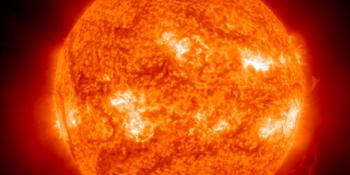Visualizzazione archivio di mercoledì, 7 marzo AM
Rapporto attività solare
Ogni brillamento solare menzionato nel rapporto ha un fattore di scala, applicato dal Centro di Predizione Meteorologica Spaziale (SWPC). A causa del fattore di scala del SWPC, i brillamenti solari sono segnalati come ridotti del 42%, rispetto ai dati di qualità scientifica. Il fattore di scala è stato rimosso dai nostri dati archiviati sui brillamenti solari, per riflettere le unità fisiche reali.
Rapporto dell'Attività Geofisica Solare 2012 Mar 07 2200 UTCPreparati dal SWPC della NOAA© ed elaborati da SpaceWeatherLive.com
Rapporto Congiunto USAF/NOAA dell'Attività Solare e Geofisica
SDF Numero 067 Emesso alle 2200Z il Mar 07 2012IA. Analisi delle Regioni Solari Attive e Attività dalle 2100Z-06 alle 2100Z-07 Solar activity was high. Region 1429 (N17E15) produced
an X5/3B long-duration flare with maximum at 07/0024Z. The event was
associated with type II and type IV radio sweeps and a full halo,
though slightly asymmetric coronal mass ejection (CME). The CME had
an estimated plane of sky speed of about 2200 km/s. During the decay
of the X5 x-ray event, Region 1430 (N21W00) produced an X1/Sf at
0114Z. Region 1429 dominates the disk with an area of about 1300
millionths. Observations show slight separation of the central spots
but the region continues to be large and magnetically complex;
multiple deltas are clearly evident as well as a dominant east-west
polarity inversion line. Region 1430 showed steady growth during the
past 24 hours. Region 1428 (S17W05) also showed growth during the
period but was relatively quiet and stable.
IB. Previsione dell'Attività Solare
Solar activity is expected to be
moderate to high. M-class level activity is expected to continue and
there continues to be a good chance for an additional major flare
and/or proton producing event from Region 1429. In addition, the
growth trend in 1430 suggests that it may also contribute to the
M-flare activity during the next three days.
IIA. Sommario dell'Attività Geofisica dalle 2100Z-06 alle 2100Z-07
The geomagnetic field ranged from quiet to major storm levels during
the past 24 hours. Activity levels were initially quiet to unsettled
until an interplanetary shock arrived. The shock was seen at ACE at
07/0334Z and was followed by a sudden storm commencement (SSC) at
Earth at 07/0421Z. Although solar wind speeds did not increase
greatly, the interplanetary magnetic field (IMF) and density did
increase markedly and the Bz component had numerous intervals of
fairly strong southward orientation (with the strongest negative
intervals at about -15 to -20 nT). Geomagnetic activity increased to
minor to major storm levels following the SSC with some periods of
severe storm levels at high latitudes. The disturbance most likely
originated from the X1/halo CME that occurred on 05 March. A greater
than 10 MeV proton event began at 07/0500Z and has reached a peak so
far of 1630 PFU at 1540Z. A greater than 100 MeV proton event also
occurred, beginning at 07/0405Z and reaching an apparent maximum of
69 PFU at 07/1525Z. Both of these events continue in progress and
are clearly associated with todays X5/Full halo CME event.
IIB. Previsione dell'Attività Geofisica
The geomagnetic field is
expected to be active initially on day 1 (08 March) but is expected
to increase to major storm levels with a likelihood for isolated
severe storm levels after the arrival of the CME from todays
X5/full halo event. The arrival time is estimated to be sometime
between 0600-1000Z. Minor to major storm levels are expected to
continue partway (6-12 hours) into the second day (09 March), but a
decline to predominantly active levels is expected for the remainder
of the day. Predominantly unsettled levels are expected for the
third day (10 March). The greater than 10 MeV proton event is
expected to continue through the first day and is also likely to
continue partway through the second day. The greater than 100 Mev
proton event is expected to slowly decline over the next 24 hours.
III. Probabilità dell'Evento dalle Mar del 08 alle Mar del 10
| Classe M | 85% | 85% | 85% |
| Classe X | 40% | 40% | 40% |
| Protone | 99% | 80% | 50% |
| PCAF | red | ||
IV. Flusso di 10.7 cm di Penticton
Osservato 07 Mar 136 Previsto 08 Mar-10 Mar 140/140/135 Media di 90 Giorni 07 Mar 125
V. Indici Geomagnetici A
Osservato Afr/Ap 06 Mar 010/009 Stimato Afr/Ap 07 Mar 036/050 Previsto Afr/Ap 08 Mar-10 Mar 047/075-018/028-007/015
VI. Probabilità dell'Attività Geomagnetica dal 08 Mar al 10 Mar
| A. Latitudini Medie | |||
|---|---|---|---|
| Attivo | 15% | 20% | 25% |
| Tempesta minore | 40% | 40% | 15% |
| Tempesta maggiore-grave | 45% | 30% | 05% |
| B. Latitudini Alte | |||
|---|---|---|---|
| Attivo | 05% | 25% | 15% |
| Tempesta minore | 10% | 35% | 30% |
| Tempesta maggiore-grave | 85% | 25% | 45% |
Tutti gli orari in UTC
<< Vai alla pagina della panoramica giornaliera
Ultime notizie
Ultimi messaggi dal forum
AR 3959 13Unspecified geomagnetic activity 1836Filaments and prominences 612IP cameras for sky surveillance 40SEEDS is down? 21
Altri argomentiSupporta SpaceWeatherLive.com!
Molte persone vengono su SpaceWeatherLive per seguire l'attività del Sole o sapere se ci sia la possibilità di vedere l'aurora, ma a maggior traffico corrispondono costi maggiori. Considerate una donazione se vi piace SpaceWeatherLive così che possiamo mantenere online il sito web!

Notizie sul meteo spaziale
| Ultimo brillamento X | 2025/01/04 | X1.85 |
| Ultimo brillamento M | 2025/01/09 | M1.1 |
| Ultima tempesta geomagnetica | 2025/01/04 | Kp5 (G1) |
| Giorni senza macchie | |
|---|---|
| Ultimo giorno senza macchie | 2022/06/08 |
| Media mensile Numero di Macchie Solari | |
|---|---|
| dicembre 2024 | 154.5 +2 |
| gennaio 2025 | 140.8 -13.8 |
| Last 30 days | 151.7 +34.3 |


